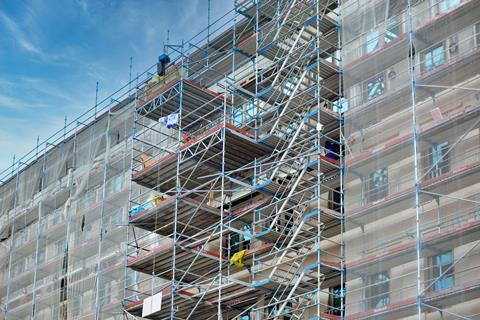The surveyors institute hopes new guidance will unlock mortgage lending where work is yet to be carried out
The Royal Institution of Chartered Surveyors is seeking views on new guidance for valuers of residential flats in multi-storey blocks with cladding.
Lenders have since the Grenfell fire been reluctant to lend on properties in blocks needing remediation, but recently committed to giving mortgages on these homes again.

RICS said that this commitment and new statutory leaseholder protections, brought in with the Building Safety Act in June, meant this “positive step”, in the form of this new guidance, was possible.
The guidance is designed to allow mortgage lenders to value buildings of more than 11m in height that are in need of cladding remediation but where work has not yet been either started or completed. The aim is that residents whose homes fail an EWS1 or other cladding assessment aren’t trapped in an unsellable home until remediation work is complete.
The guidance should “play an important part in restoring a fully functioning market”, the institution said.
“The proposed guidance supports RICS valuers to take a consistent and transparent approach in undertaking valuations for mortgage purposes on domestic residential blocks of flats.”
The trade body consulted with the fire safety industry, valuers, insurers, conveyances and lenders to draw up the advice.
However, the RICS said it could only be used where “remediation work to cladding for fire safety purposes has been identified, a route to funding remediation is clear, and lenders have indicated their willingness to lend.”
It said the aim of the approach is that it reasonably balances the relevant risks and uncertainties in the valuation process.
The guidance should support the valuer in their “assessment of value and the appropriate and special assumptions of properties in buildings where remediation works are required”.
If a valuer does not have the “required level experience to deal with some aspect of the valuation assignment property” they should decline the instruction or agree with the client what assistant is needed, the RICS said.
>> EWS1 forms will still be used for several years, lenders warn
>> How lenders are responding to the government’s EWS1 form announcement
>> When will the flat valuation blockage finally come to an end?
Factors valuers valuing flats in blocks with cladding should assess, are the impact on amenity in the property while remediation is taking place, whether the property is still able to be occupied when the work is taking place and any heating or cooling issues while the property is being insulated.
RICS predicted that that with the Fire Safety Act and Building Safety Act, reliance on the external wall form EWS1 will “reduce further”, although government figures suggest its use has been rising despite former housing secretary Robert Jenrick officially scrapping the advice last summer.
The consultation also stated RICS anticipated the controversial Fire Risk Appraisals of External Walls (FRAEW) form will soon be ”falling in line of the normal FRA process according to BSI PAS 9980 – a standard that RICS helped to create”.
At the start of this year, the British Standards Institution published the PAS 9980 180-page guidance called PAS 9980, which is a code of practice for fire risk assessments of external walls under the Fire Safety Act 2021 amendments.
The consultation on RICS guidance for valuers began yesterday will run until 26 October. Valuers will be expected to start using the guidance from 1 December but RICS is urging them to apply it sooner.











No comments yet